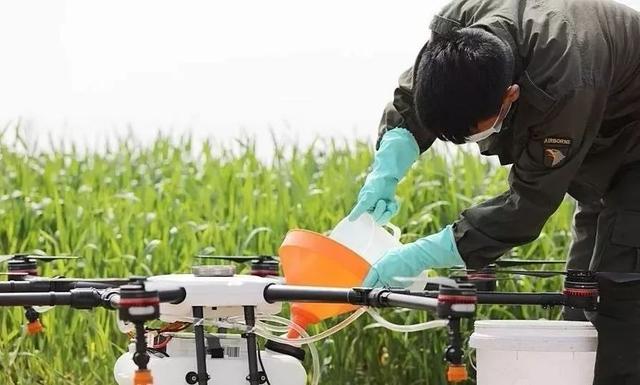Comprehensive analysis of the application status of plant protection drones in China Leave a comment
China’s pesticide utilization rate is only 20%, most of which is lost in the environment, causing environmental pollution and waste of resources. Therefore, advanced application techniques and application equipment are urgently needed.
From the perspective of agricultural development abroad, the use of aircraft for aerial spraying is currently a more efficient means of spraying. Airborne pesticide application can effectively control the occurrence of large-scale pests and diseases in a timely manner. Compared with ground spray, it has the advantages of high working efficiency, no limitation of terrain factors, uniform application and good penetration. At the same time, the separation of man and machine during the application of chemicals can reduce the impact of the medicament on people. The down-spin air flow generated by the aircraft can effectively reduce the drift of the medicament and reduce the harm to the environment.
Based on the advantages of the above-mentioned aerial pesticide application equipment and China’s vast land area, complicated terrain and diversified planting models, the use of aerial pesticide application is more in line with China’s current national conditions and therefore has potential value for popularization.
Development of foreign aviation pesticide application technology
Initially, it was proposed by Germany to use airplanes to spray pesticides to control forest pests and diseases.
In 1918, the United States first sprayed arsenic preparations with airplanes to control forage pests. Since then, other developed countries have also begun to use airplanes to control pests and diseases.
After World War II, with the large-scale development of new chemical pesticides, the demand for new pesticides on the development of medical equipment has increased. At the same time, a large number of aircraft were transferred to agriculture after the war, which promoted the development of aviation pesticide application technology. After the 1950s, agricultural aircrafts for pesticide application were developed one after another, and helicopters were also developed for aerial plant protection.
The United States is the country with the most advanced agricultural aviation technology in the world, with advanced aviation plant protection machinery and a complete agricultural aviation organization system.
The United States also uses the most advanced application technology in the field of aerosol application. The United States has about 9,000 agricultural aircraft (13% are agricultural helicopters), about 4,000 aircraft actually in use, more than 2,000 registered agricultural aircraft pilots, 65% of the US chemical pesticides are sprayed by aircraft, and the annual treatment of cultivated land area More than 1.2 million hm2, accounting for more than 50% of the total cultivated land area, an average of 20,000 hm2 cultivated land has an agricultural aircraft.
The large-scale production model of farms in the United States has gradually established a pest control system based on aerial plant protection machinery and large plant protection machinery.
In 1966, the United States established the National Agricultural Aviation Association. According to statistics from the association, Agricultural Aviation is now responsible for nearly 20% of farm plant protection and 100% forest plant protection in the United States. Agricultural aviation completes more than 28 million ha of farmland operations each year.
In terms of control targets, as of 2012, agricultural aviation has been applied to almost all kinds of crops, among which the five types of crops such as corn, wheat, soybean, pasture and alfalfa have the most extensive control area. At present, American aviation agricultural aircraft are dominated by fixed-wing aircraft, accounting for about 87%, and rotorcraft helicopters are about 13%.
Japan was the first to use unmanned helicopters for agricultural production. After years of development, Japan has become one of the most developed countries in this field.
Japan ’s land area is relatively small, and it has many mountainous areas, less arable land, and small agricultural management scale. It is difficult for large-scale plant protection equipment to adapt. Therefore, Japan has chosen to develop small size, flexible maneuverability, easy operation, small amount of application liquid per unit area, and operating efficiency High drone.
In 1985, Yamaha Corporation of Japan first introduced the first agricultural “R-50” drone, mainly used for aerial pesticide application.
From 1995 to the end of October 2005, the number of registered plant protection drones in Japan increased from 307 to 2002, an average annual increase of 13.8%. For the unmanned aerial vehicles used in forestry construction, Yamaha’s Rmax series alone has more than 1,200 aircraft, and the prevention and control area has increased from 200,000 hm2 to 600,000 hm2, exceeding the control area of manned helicopters.
As of 2012, the annual working area of agricultural drones in Japan reached 963,000 hm2, accounting for 50% to 60% of the planted area. It has 2346 unmanned helicopters and 14 163 unmanned aerial vehicles. Since 2015, some companies have begun to promote multi-rotor drones.
Development of domestic aviation pesticide application technology
China’s aviation spraying started relatively late. It can be traced back to the early 1950s. At that time, it was mainly manned fixed-wing aircraft, such as “Y-5B (D)”, “YU”, etc. Occupy the main position of flying defense in time.
In the 1990s, the pesticide spraying equipment specially configured for light aircraft such as “Haiyan” was developed, which can be widely used for the prevention and control of pests and diseases of field crops such as wheat and cotton, and can also be used for chemical weeding, forest pest and disease control, and grassland extermination Locust, foliar fertilization, spray application of cotton defoliant, etc.
In 1995, the “Blue Eagle AD200N” developed by Beijing Keyuan Light Aircraft Industry Co., Ltd. began to be used in flight prevention practice, mainly used for the prevention and control of diseases and insect pests in farmland and forest areas, as well as sanitation and epidemic prevention. .
In 1999, the Chinese Academy of Forestry integrated an ultra-low-capacity spraying device and a GPS navigation system on the “Haiyan 650B” UAV, and conducted a pilot study on the prevention and control of pests and diseases in the Wuming forest area of Guangxi Province. At present, China has 1,400 fixed-wing aircraft and more than 60 helicopters for agriculture and forestry. The area of fixed-wing aircraft and helicopters used to prevent and control agricultural, forestry diseases, pests, weeds, and fertilization has reached more than 2 million hm2. However, there is still a huge gap between China and the United States, Japan, Germany and other countries with advanced aviation plant protection, and they still lag behind in terms of agricultural aircraft ownership, annual flight defense area and technology.
At present, the agricultural plant protection drones commonly used in China mainly include “Eagle-3”, “Z-3”, DJI “MG-1”, single-rotor “CAU-WZN10A” and multi-rotor “FDXD-8R-22L”.
In the past 10 years, low-altitude and low-volume operation plant protection drones have developed rapidly. According to statistics from the Ministry of Agriculture, as of May 2016, there are 178 agricultural drones in use nationwide, which can be applied to different application conditions. The spraying efficiency is as high as 6 hm2 / h, which can effectively prevent crop diseases, insects and weeds in a timely manner.
At present, agriculture and forestry aviation operations are 33 158 hours, which are mainly used in the main grain crop production areas such as Heilongjiang, Inner Mongolia, Xinjiang and Henan, but less than 3% of the total plant protection operation area. According to the report of the Ministry of Agriculture, the demand for efficient plant protection machinery will be strong in 2018, and plant protection drones will continue to heat up. The demand is expected to be around 8,000, and the operating area is expected to reach 200 million mu. At present, more than 95% of the national agricultural aviation technology is used for aerial plant protection operations, and about 5% is used for agricultural information acquisition, aerial photography, and auxiliary breeding of crops.
The agricultural plant protection drones used in China can be divided into two types: electric and mobile according to power, and they are mainly divided into two types: single rotor and multi-rotor according to the structure. There are many types, and the weight difference of empty aircraft is large. Low-altitude operations are generally below 5 m. The speed is slow.
The power core of electric drones is the motor. The electric drones are flexible in operation, take off and land quickly, have a small amount of drug liquid, and have a short flight time. Battery life is one of the main factors limiting their use.
The core of the power of the mobile UAV is the engine, which has poor flexibility and requires a certain take-off and landing time, but the amount of drug-loaded liquid is large, and the single flight time can reach 1 h, which requires high operators and the maintenance of the aircraft becomes the scale of its use. disease. Single-rotor drones have a large load capacity, which can carry 5-20 L, and some models can be higher; multi-rotor drones are mostly electric and have a small load, but their structure is simple and the flight is stable, which is more popular with new pilots. Welcome.
As of 2016, there have been more than 200 drone production and sales companies in China, and more than 160 agricultural drones have been put on the market to carry out disease and pest control work on crops such as rice, wheat, corn, cotton and sugarcane. The actual effect proves that drone aerial application meets the requirements of practical application and is in a stage of rapid development.
The artificial control of drone flight and pesticide application can no longer meet the current agricultural development. With the implementation of precision pesticide application, the artificially controlled large-area spraying gradually shows its drawbacks, and the development of advanced control technology is imperative.
In recent years, with the development of information technology, more and more new technologies are connected with drones, such as remote sensing technology, GPS navigation technology, GIS system, DSS system and other new technologies, to promote the further development of aviation plant protection.
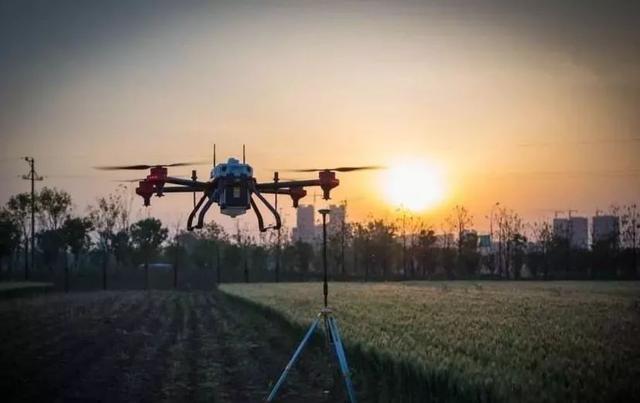
Application of plant protection drone in agriculture
Drones have many uses in agriculture, including the survey and assessment of pests and diseases, the prevention and control of pests by aerial pesticide application, and the investigation of forest fires. Unmanned aerial vehicles can adapt to different working environments and have high working efficiency. They can be solved in places where high risks or human activities are difficult to reach.
For example, in the survey of diseases and insect pests, combined with advanced sensors to accurately evaluate pests and diseases, and use the computer to process the data, the best control strategy can be obtained; in forest fire observation, the drone has a far field of view and accurate detection Ability; in terms of aerial pesticide application, drones can adapt to different application environments, have high operating efficiency, are not restricted by crop growth, have wide adaptability, and use less liquid medicine, which is conducive to saving liquid medicine and protecting the environment.
UAV application in corn
As a raw material for food, livestock and poultry and industrial raw materials, corn has a high use value and economic value. China’s corn production areas are all over the country, and the advantageous areas for corn cultivation are mainly distributed in the northeast and the vast area extending southwest through the Huanghuai Sea. According to statistics from relevant departments, corn has become China’s largest food crop.
Due to climate change and other reasons, corn diseases and insect pests are common. In addition, corn has a special growing environment, tall and densely planted, no air circulation, poor application conditions, coupled with unsatisfactory sales prices in recent years, farmers’ enthusiasm for controlling corn diseases and insect pests has declined. The use of drones can effectively monitor the diseases and insect pests of corn and natural disasters. In addition, the application of drones also solves the problem of difficult application in corn fields, and has a broad development prospect.
Since 2015, based on the application of digital images to the diagnosis of nitrogen nutrition in winter wheat and summer corn, Li Hongjun et al. Have used an onboard digital camera to study the relevant color parameters of canopy images at different aerial heights to invert the nitrogen in winter wheat and summer corn Differences in nutritional status, establishing a model for diagnosing nitrogen nutritional status of winter wheat and summer maize using aerial digital images of unmanned aerial vehicles.
The results show that although this technology needs to be further improved, it is feasible to use a drone equipped with a digital camera to diagnose nitrogen nutrition of winter wheat and summer corn.
Li Zongnan and others optimized the method of using UAV remote sensing technology to obtain the area of corn lodging, which used the UAV remote sensing experiment to obtain red, green, and blue color images, and calculated and counted the color and texture characteristics of normal and lodging corn, and then compared the characteristics The coefficient of variation and relative difference are used to select the characteristics suitable for distinguishing normal and lodging corn, and on this basis, the area of corn lodging can be accurately calculated. In addition, Wu Caicong and others have also established a semi-variable fitting function and prediction model for predicting the spatial distribution of corn borers using drones, which provides a theoretical and technical basis for precise application of pesticides, thereby saving medicines and protecting the environment.
In 2012, Gao Yuanyuan and others used the AF-811 small single-rotor unmanned helicopter to control corn borers, and measured the distribution and distribution of fog droplets under different flight parameters and the control effect against corn borers.
The results of the study found that at a flying height of 2.5 m, the 10% chlorpyrifos ultra-low volume liquid agent had the best control effect. The number of droplets in the ear reached 15.6 / cm2, and the control effect was as high as 80.7%; when using 42% chlorpyrifos emulsifiable concentrate The treatment efficiency is only 69.1%, and the prevention efficiency is increased to 75.8% after adding the evaporation inhibitor. Compared with the self-propelled high-pole sprayer, the drone has the advantages of time saving, labor saving and water saving. In terms of prevention efficiency, various parameters still need to be further optimized. Yang Shuai and others used TXC-8-5-0-1 eight-rotor drone to spray 3% phenoxycarb emulsifiable concentrate to control corn borers at ear stage. They compared different flying heights, the amount of application liquid and the addition of evaporation inhibitors to the mist droplets. Effects of sediment distribution and corn borer control.
The results show that the flying height is within the range of 2.0 m, and the locality has no effect on the width of the drone spray. The optimal flying locality is 1 m from the corn canopy, and the optimal amount of control solution is 12 L / hm2. Under the conditions, the deposition density of fog droplets on the ear is 20.4 / cm2, and the control effect is 79.6%. In addition, the addition of transpiration inhibitors can effectively increase the number of droplets deposited and the prevention effect. The application of aerial plant protection pesticides has solved the problem of pesticide application in corn fields, and corn has been significantly affected by pests and diseases. It has become one of the most direct and effective methods to ensure high quality, high yield and stable yield of corn.
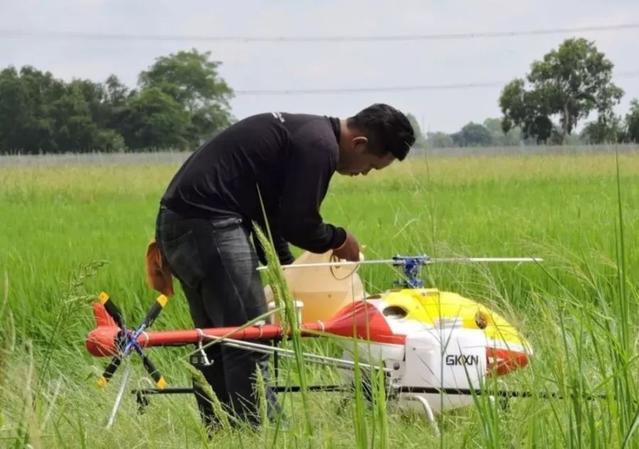
UAV application in rice fields
Rice is the second largest food crop in China, with a planting area of 3.06 million hm2 and a self-sufficiency rate of over 99%. However, due to scattered land, the average planting area per household is only about 1.15 hm2. The planting, transplanting and harvesting of rice have all been mechanized and the work efficiency has been improved. However, the chemical control equipment for rice is backward and still stays in the artificial control stage, which not only causes artificial waste, but also can easily miss the best control period if it is not timely.
With the industrialization of rice cultivation, the development of medical equipment has become a new problem restricting the prevention and control of rice diseases and insect pests. Because the land machinery is difficult to work in the field during rice growth, conventional spraying has high labor intensity, and it is difficult to reach the middle and lower parts of the rice. The operation efficiency is low, and it is also easy to cause harm to the sprayers and the environment. In view of this, plant protection unmanned aerial vehicles are welcomed by virtue of low drug consumption, precise operation, and low labor intensity, which can achieve mechanized, professional, and integrated control of rice diseases and insect pests.
In order to explore the deposition and distribution rules of drone spray droplets on the rice canopy, Chen Shengde et al. Conducted related research using the HY-B-10L single-rotor electric drone. The experiment used Li Chunhong as a tracking dye and used Deposit Scan The image processing software processes the deposition and distribution of fog droplets.
The results show that the amount of droplet deposition is significantly related to the flight height and flight speed. With the increase of flight altitude and flight speed, the amount of droplet deposition is gradually decreasing, and during the application process, the distribution of the drug solution will be affected by the external wind. Field impact. This result comprehensively reveals the influence of operating parameters on the results of aerosol spray droplet deposition and distribution, and has very important guiding significance for the rational spraying of the chemical liquid and improving the spraying efficiency.
Aerospray can be applied to various stages of rice growth period. Xue Xinyu et al. Studied the control efficacy and application prospects of rice planthopper and rice leaf roller borer by screening N-3 drone application parameters. As a result, it was found that the aircraft had the best effect and the highest control effect at a height of 3 m. In addition, compared with the traditional stretcher sprayer, the effect was better. Moreover, the small UAV has small volume, high flexibility and good terrain adaptability, and can play its role even in hilly areas.
UAVs have also played an important role in the monitoring of rice growth physiology and pest and disease status. Qin Zhanfei et al. Used drone and airborne remote sensing technology to determine the total nitrogen content of rice leaves in Ningxia Yellow River Irrigation Area. The experiment established an optimal estimation model for the total nitrogen content of rice leaves, which can accurately determine the total nitrogen content of rice leaves. The spatial inversion of nitrogen content in rice and the efficient implementation of precision agriculture provide scientific basis and technical support.
In addition, the use of drones to pollinate rice has been active in recent years. In order to improve the efficiency of mechanized planting of hybrid rice, Li Jiyu et al. Studied the distribution law of the wind field of the rice canopy rotor when pollinated by a drone. The experiment used 18-rotor unmanned aerial vehicle to pollinate rice, and established an ideal model of the X-dimensional two-dimensional wind field of the UAV rotor at the rice canopy.
The width of the wind field, the size of the wind speed in all directions in the wind field, and the distribution law of the wind field will directly affect the effect of agricultural drone field operations. In addition, Li Jiyu and others also screened for different flight parameters. The SCAU-2 aircraft was selected for the experiment. It has a good pollination effect at a flight speed of 1.56 m / s, a load mass of 14.05 kg, and a flight altitude of 1.93 m.
However, the structure of different types of agricultural unmanned helicopters is different, and the wind field formed by the airflow generated by the rotors reaches the crop canopy. Effects, operating efficiency and economic benefits. Liu Aimin’s experiment on drone rice pollination found that drone pollination has higher work efficiency and less damage to plants than artificial pollination, and has good development potential in rice breeding.
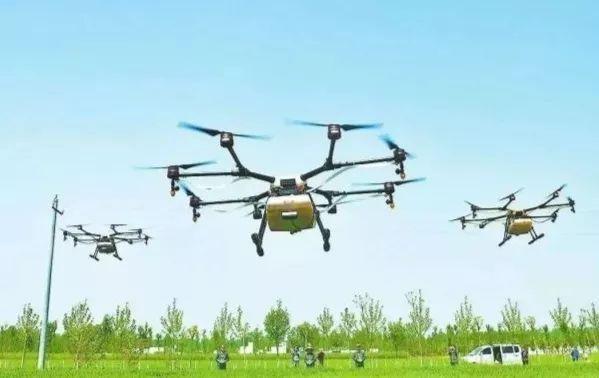
Application of drone on wheat
China’s wheat production and consumption account for about 25% of the country’s total grain. With the increase in population and the increase in consumption levels, wheat consumption is expected to continue to increase.
It is estimated that in order to ensure the food security of 1.45 billion people in 2020, wheat output needs to increase by 28% on the existing basis. In the past half century, wheat has developed rapidly in breeding, breeding, promotion, production, etc. However, in the face of the intensive planting and the shortage of labor resources, the pest control has become unsatisfactory, which has seriously affected wheat. Yield and quality.
Drones play a key role in monitoring wheat growth and plant diseases and insect pests. Similar to corn and rice, the drone can determine the supply and demand of wheat nitrogen based on wheat growth, and can accurately fertilize areas lacking nitrogen to reduce waste of resources and environmental pollution.
UAV remote sensing technology can also be used to obtain wheat breeding information. Yang Guijun and others have developed a wheat breeding information acquisition system based on multi-load UAV remote sensing as a platform, which integrates a multi-spectral instrument, high-definition digital camera, and thermal imager And other sensors, establish a geometric correction model of UAV remote sensing data without ground control points, to achieve geometric correction of multi-load remote sensing data.
The system can accurately obtain key phenotypic parameters such as leaf area index, crop lodging area, yield and canopy temperature, and provide auxiliary support for the study of the correlation between wheat breeding phenotype and genotype. In addition, there is also the application of drones in the investigation of wheat diseases. Qiao Hongbo et al. Used drone digital image and hyperspectral data fusion technology to investigate and classify the incidence of wheat total erosion; Leng Weifeng and others used UAV remote sensing technology monitors wheat stripe rust, and finds that using drone remote sensing to monitor wheat stripe rust is feasible and has certain development potential.
At present, in the wheat seedling stage, weeds have become the most important factor affecting wheat growth, especially in Anhui and Henan provinces.
Gong Xiaoling et al. Selected four types of medicinal equipment for pesticide application treatment and compared the prevention effects. It was found that the rotor drone application has a better field control effect than conventional ground application and has the value of promotion. Zhu
Dehui et al. Used plant protection drones to carry out chemical weeding in winter wheat fields. The test results showed that the drone application had a good weeding effect, effectively controlled the damage of weeds in wheat fields and was safe for wheat growth.
Fusarium head blight, powdery mildew, and sheath blight are collectively referred to as the “three major diseases” on wheat in the middle and lower reaches of the Yangtze River, which have gradually increased in recent years.
Chen Yinfeng and others used multi-rotor drones to explore the control effects on sheath blight, powdery mildew, and scab, and found that drones can significantly improve spray efficiency and have better control effects than traditional pesticide application equipment. However, the drone has no difference with the traditional medicine equipment in the prevention of wheat scab in ears, and even lower than the traditional medicine equipment.
Wheat rust and aphids also severely damage wheat, causing diseases and insect pests that affect wheat yield.
Yang Fusheng used two kinds of medical equipment to prevent and control wheat diseases and insect pests, and found that the spraying control effect of the artificial piggyback motorized sprayer was slightly higher than that of the drone. However, the UAV has more advantages in the prevention and control of pests and diseases, and has the advantages of fast application of pesticides, ease of operation, and cost savings.
At present, drones show unique advantages in wheat control, and are becoming more and more common in the process of wheat application, especially under the guidance of the “one spray and three prevention” technology, using drones to spray wheat on a large scale For medicine operations, only 2 mm is needed to complete the operation per acre of wheat field, which greatly improves the operation efficiency and guarantees a good harvest of summer grain.
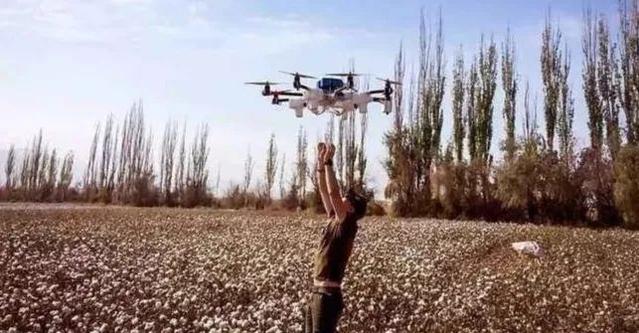
Drone application in cotton
Cotton is an important strategic material related to China’s national economy and people’s livelihood. It is also an important industrial raw material for the cotton textile industry and occupies an important position in the national economy. China is a major cotton producer and consumer in the world, but cotton production has faced many problems in recent years. Cotton production relies on labor, low mechanization, large plant protection equipment damages cotton plants and fruits, poor pest control effects, and backward plant protection technology. The high efficiency of drone application, flexible operation at low altitude, and precise spraying, greatly reduce the labor intensity, and open up a new path for the mechanization of cotton production.
In the production of cotton, the monitoring of growth status and pests and diseases and the prevention and control of pests and diseases are also indispensable. Taking advantage of the high spectral resolution of UAV images, Tian Minglu et al. Extracted 27 spectral parameters, constructed an inversion model of the relative chlorophyll content of cotton leaves, and made a distribution map of the relative chlorophyll content of cotton leaves.
The results show that the model can be used to obtain an ideal prediction effect and can be used as a technical means for remote sensing monitoring of the relative chlorophyll content of cotton leaves. Tian Minglu and others also measured the leaf area index of cotton through the imaging technology of the UAV imaging spectrometer, and used the low-altitude UAV remote sensing platform to invert the cotton leaf area index using the hyperspectral image data of the farmland obtained by the new imaging spectrometer to establish the leaf area index The remote sensing estimation model provides new technical means for remote sensing monitoring of crop leaf area index.
The application of drone application on cotton is mainly focused on aphids control and spraying growth regulators.
Zhao Bingmei et al. Used KT-10-II four-rotor plant protection drone to spray 50% fipronil water dispersible granules at low altitude to control cotton aphids. The experimental results show that the drone fly control has a good control effect on cotton aphids , Continue to add spray additives can further reduce the dosage.
Wang Yuantao is equivalent to using DJI MG-1 plant protection drone low-altitude and low-volume spray in 2017 and conventional spray. The results show that compared with conventional spray, plant protection drone has high working efficiency, low control cost and good control effect. Save labor, labor and water consumption.
Xianmin et al. Used DJI plant protection drone to spray cotton defoliant. The experiment showed that the plant protection drone once applied the same defoliation effect as the locomotive second application. In general, plant protection drones have good application prospects for cotton pesticide application.
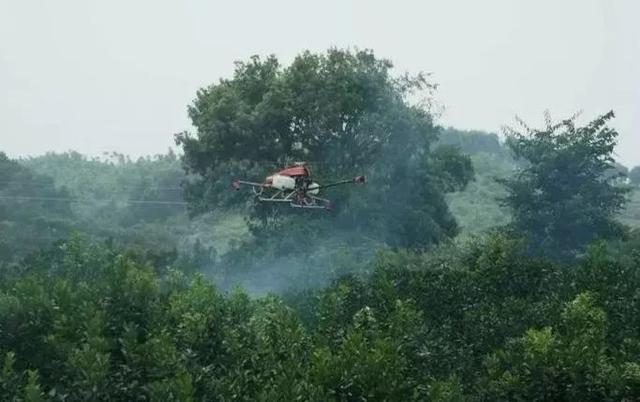
Application of drones in forest
Forests have three major economic, ecological and social benefits. In order to achieve the sustainable development of forestry and meet the precise monitoring and information management of today’s forest resources, drones and related technologies have played a pivotal role. In the construction of forestry, drones are mainly used in forest census, forestry resource survey, forest fire monitoring and fire prevention, and forest pest control.
China has a vast forest area, and it is particularly difficult to investigate forest resources and prevent forest fires.
Shi Jieqing and other studies used high-precision UAV remote sensing images to investigate forestry resources, experimented with photogrammetry technology, post-processing technology of UAV images, geographic information system technology and forestry resources survey management technology, and developed suitable for forestry resources. The professional forestry resource survey system for investigation and management uses the UAV image data to realize the functions of forest land spatial division, high-precision forest survey, information extraction and other functions. Through this system, the resource database can be updated in time, greatly reducing the traditional survey model. The investigation cycle has realized the scientific management of forest resources.
Xu Zigan et al. Based on high-resolution unmanned aerial vehicle images and lidar point cloud data to estimate the basic characteristic variables of subtropical natural secondary forest stands, construct a high-precision digital elevation model under the forest, which can quickly reflect the forest stand characteristics. UAV platform forest fire monitoring and alarm has the characteristics of low operating cost, easy operation, flexible maneuverability, etc. It has a broad prospect in patrolling and monitoring forest fires. Fan Haoran et al. Developed an infrared detector to detect and alarm the forest fire point, and used a low-cost 4-rotor drone as an inspection platform. The results show that the system can quickly and accurately locate the fire point without real-time monitoring by personnel , Provides a solution for forest fire prevention and rapid fire fighting command.
Real-time monitoring and accurate evaluation of the occurrence of forest diseases and insect pests is a prerequisite for proposing control strategies, carrying out control work, and improving control efficiency. With the help of drones, combined with remote sensing, infrared detection and other technologies to observe forest pests and diseases, you can understand the dynamic changes of pests and diseases, find the rules of pests and diseases occurrence, integrate analysis and predict the trend of pests and diseases spread, establish a model of pests and diseases, Obtain a longer-term and more scientific forest pest forecast results. In the early stages of the occurrence of pests and diseases, do a good job of prevention to avoid the further spread and spread of pests and diseases.

